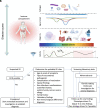Management of Inborn Errors of Immunity in the Genomic Era
- PMID: 35383007
- PMCID: PMC9366268
- DOI: 10.5152/TurkArchPediatr.2022.22033
Management of Inborn Errors of Immunity in the Genomic Era
Abstract
Inborn errors of immunity are a group of rare diseases characterized by a wide variety of manifestations, including unusually severe infections, cancer susceptibility, and exaggerated inflammation that disrupts organ function. As of 2022, over 450 gene deficiencies have been classified under ten categories, where numbers are constantly increasing. The range of inborn errors of immunity varies considerably, from mild infections to serious multisystemic disease. Whereas patients with T cell defects are liable to a broad range of pathogens, selected inborn errors of immunity may predispose hosts merely to a narrow range of microorganisms. Dysregulated immune responses often cause autoimmune manifestations that may target any organ or lead to severe allergies. Therefore, presentation to any medical discipline is possible. Historically, inborn errors of immunity have been associated with short life expectancy and poor life quality, but intensive research into the field has revolutionized this assumption. Especially with the aid of translational investigations, our clinical practice has transformed from a predominantly phenotype-driven management into one that is reinforced by an etiology-driven therapy. This review summarizes the recent advances in molecularly targeted treatment approaches in various inborn errors of immunity conditions, with many success stories corroborating the power of genomic medicine. The principles of applications learned from these rare monogenic traits, in which the functional impact of the molecular pathways is clear-cut, may be instructive for developing basic concepts toward precision therapy of the common immune-mediated disorders, including autoimmunity, infectious diseases, and allergy, which affect mass populations.
Figures




References
LinkOut - more resources
Full Text Sources
Research Materials
